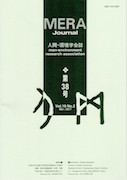Volume 16, Issue 2
Displaying 1-19 of 19 articles from this issue
- |<
- <
- 1
- >
- >|
-
Article type: Cover
2014Volume 16Issue 2 Pages Cover1-
Published: March 20, 2014
Released on J-STAGE: March 19, 2019
Download PDF (30837K) -
Article type: Index
2014Volume 16Issue 2 Pages Toc1-
Published: March 20, 2014
Released on J-STAGE: March 19, 2019
Download PDF (40K) -
Article type: Article
2014Volume 16Issue 2 Pages 1-10
Published: March 20, 2014
Released on J-STAGE: March 19, 2019
Download PDF (11934K) -
Article type: Article
2014Volume 16Issue 2 Pages 11-16
Published: March 20, 2014
Released on J-STAGE: March 19, 2019
Download PDF (9825K) -
Article type: Article
2014Volume 16Issue 2 Pages 17-
Published: March 20, 2014
Released on J-STAGE: March 19, 2019
Download PDF (185K) -
Article type: Article
2014Volume 16Issue 2 Pages 18-19
Published: March 20, 2014
Released on J-STAGE: March 19, 2019
Download PDF (3990K) -
Article type: Article
2014Volume 16Issue 2 Pages 20-23
Published: March 20, 2014
Released on J-STAGE: March 19, 2019
Download PDF (12450K) -
Article type: Article
2014Volume 16Issue 2 Pages 24-28
Published: March 20, 2014
Released on J-STAGE: March 19, 2019
Download PDF (10593K) -
Article type: Article
2014Volume 16Issue 2 Pages 29-32
Published: March 20, 2014
Released on J-STAGE: March 19, 2019
Download PDF (9622K) -
Article type: Article
2014Volume 16Issue 2 Pages 33-35
Published: March 20, 2014
Released on J-STAGE: March 19, 2019
Download PDF (343K) -
Article type: Article
2014Volume 16Issue 2 Pages 36-37
Published: March 20, 2014
Released on J-STAGE: March 19, 2019
Download PDF (9440K) -
Article type: Article
2014Volume 16Issue 2 Pages 38-39
Published: March 20, 2014
Released on J-STAGE: March 19, 2019
Download PDF (7725K) -
Article type: Bibliography
2014Volume 16Issue 2 Pages 40-
Published: March 20, 2014
Released on J-STAGE: March 19, 2019
Download PDF (3750K) -
Article type: Bibliography
2014Volume 16Issue 2 Pages 40-
Published: March 20, 2014
Released on J-STAGE: March 19, 2019
Download PDF (3750K) -
Article type: Appendix
2014Volume 16Issue 2 Pages 47-
Published: March 20, 2014
Released on J-STAGE: March 19, 2019
Download PDF (43K) -
Article type: Appendix
2014Volume 16Issue 2 Pages 47-
Published: March 20, 2014
Released on J-STAGE: March 19, 2019
Download PDF (43K) -
Article type: Appendix
2014Volume 16Issue 2 Pages 47-
Published: March 20, 2014
Released on J-STAGE: March 19, 2019
Download PDF (43K) -
Article type: Cover
2014Volume 16Issue 2 Pages Cover2-
Published: March 20, 2014
Released on J-STAGE: March 19, 2019
Download PDF (26K) -
Article type: Cover
2014Volume 16Issue 2 Pages Cover3-
Published: March 20, 2014
Released on J-STAGE: March 19, 2019
Download PDF (26K)
- |<
- <
- 1
- >
- >|
